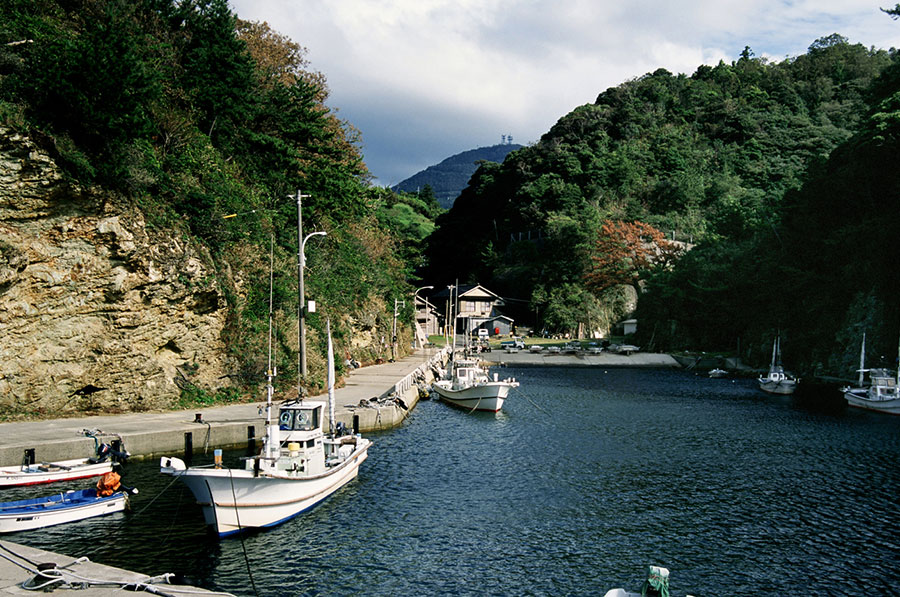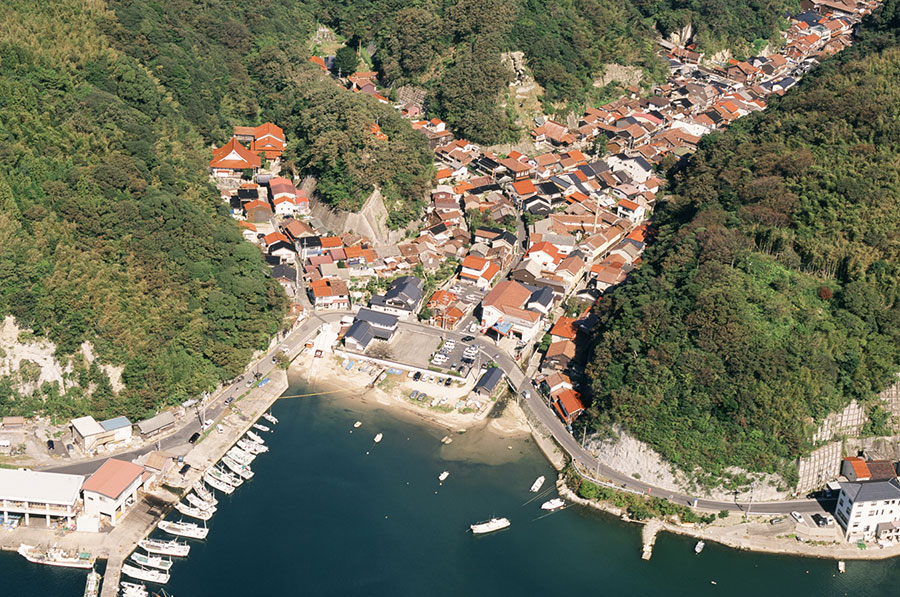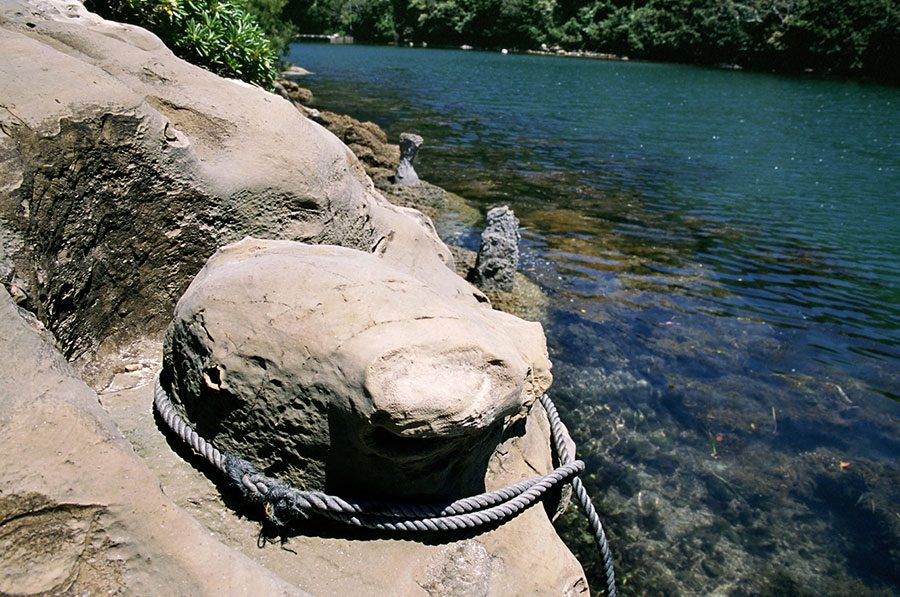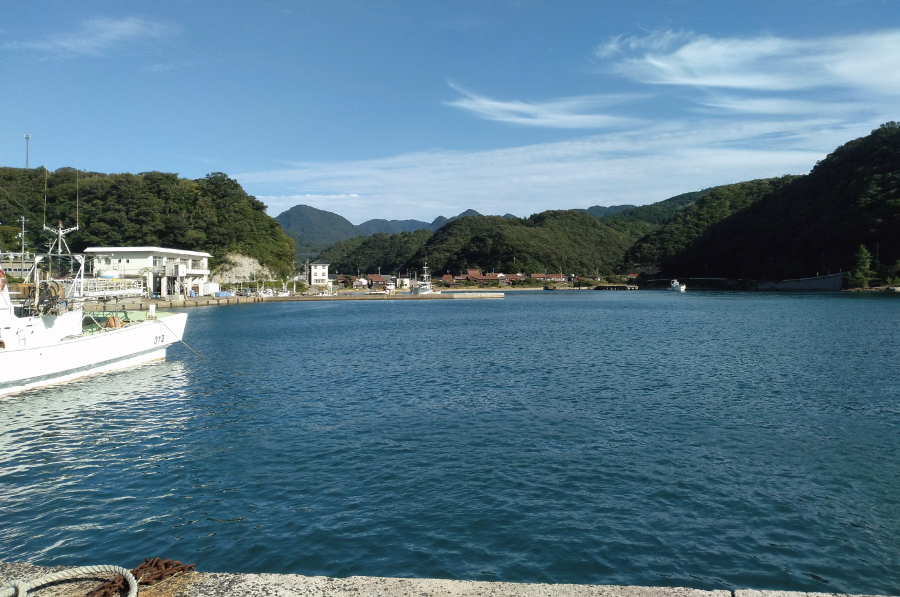Ports and Port Towns Area
1.Okidomari Port
In the history of Iwami Ginzan, Okidomari was the second port used to ship silver from the mine to markets both in Japan and overseas. When the Mohri family assumed total control over this area in 1562, they established a new road from the mine to the Sea of Japan. At the end of this path was Okidomari, which performed the dual functions of commercial port and naval base.
A fortress built by the Mohri at the mouth of the port in 1570 protected both the silver shipments from Okidomari and the supply route to the nearby harbor of Yunotsu. A village with distinctive, rectangular plots of land was established along the road near the harbor.
In the early seventeenth century, Iwami Ginzan fell under the control of the new central government based in Edo (present-day Tokyo), and the flow of silver was directed away from the coast, carried instead over land to the port of Onomichi on the Seto Inland Sea and from there to Osaka and on to Edo. Okidomari quietly transformed into a fishing village, but the sixteenth-century plots remain intact, and its Shinto shrine, where people would pray for safety on the sea, was recently rebuilt. You can also walk to the edge of the port to look out over the once fortified islands and spot the 60-odd protruding rock formations, which were carved out of the soft stone to function as mooring devices for ships transporting silver.
2.Yunotsu Onsen
The onsen (hot springs) of Yunotsu are said to have been discovered more than 1,300 years ago. According to legend, these healing waters were first noticed by a traveling Buddhist priest, who witnessed an old raccoon dog tending to a nasty cut by soaking in a pool of steaming water. This tale was supposedly told as far away as Kyoto in the Heian period (794–1185), but Yunotsu’s springs only began attracting visitors in the fourteenth century, when the settlement became a popular destination for convalescence.
Ryokan inns were built here in the Edo period (1603–1867) to house sailors whose ships docked at Yunotsu’s flourishing port. The hot springs continued to support the town after the opening of a railway station in 1918 dealt a fatal blow to the shipping industry and the shuttering of the Iwami Ginzan silver mine in 1923 depressed the region further. Today, Yunotsu is the only hot spring town in Japan to be designated a Preservation District for Groups of Traditional Buildings, and it continues to host two onsen baths.
3.Yunotsu: Sairakuji Temple and Ekoji Temple
These two Buddhist temples stand side by side at the foot of the steep cliffs that separate the town of Yunotsu from the forest. In fact, both Sairakuji and Ekoji were built partially on land obtained by removing bits of these rock walls; this task was undertaken to expand the cemeteries. Sairakuji, dedicated to the Buddha Amida Nyorai (Sanskrit: Amitabha), is the older temple. It was originally a Zen temple, but was converted to a Jodo Shinshu (True Pure Land) sanctuary in 1521; its current buildings date to 1831. The term “sanctuary” here has both religious and literal meaning: Sairakuji was traditionally a so-called muenjo (“unaffiliated place”), meaning that the temple was exempt from certain laws and obligations, and provided asylum for believers in need of protection.
Ekoji is a Nichiren Buddhist temple and has an interesting cemetery. Its distinctive, wall-like structures with small tiled roofs house the graves of local people who worked in the shipping business on the busy route between Osaka and Hokkaido along the Sea of Japan coast beginning in the late seventeenth century. The tombstones on the far left, along the cliffside, are even older; some date back to the early Edo period (1603–1867).
4.Tatsunogozen Shrine
Tatsunogozen Shrine is the main Shinto sanctuary in Yunotsu and enshrines deities related to the town’s two main sources of prosperity: the sea and the hot springs. Local people have been coming here to pray for good luck and safety at sea, and for the health benefits of bathing since ancient times: the shrine was officially founded in 1532, but its site was a place of worship long before that. The original object of reverence, a rock thought to resemble a roaring dragon, can be seen protruding from the cliffside just above the small main sanctuary (honden). In distant antiquity, rocks, trees, and other natural features were often worshiped as abodes of the divine, and the idea of enshrining deities in buildings was popularized only later. The structure at the foot of the cliff is the worship hall (haiden), which is unusually large because it was designed to accommodate performances of kagura dances to honor Shinto deities. Iwami Kagura remains a popular folk tradition in the region. The ceremonial dances are performed in the worship hall every Saturday evening, when visitors also have the opportunity to view the ema paintings featuring boats and other maritime motifs displayed in the hall.
5.Iwami Kagura
Kagura combines performance and dance in an ancient tradition that is preserved today. Believed to be Japan’s oldest performing art form, it spread across the country alongside the indigenous Shinto belief in a pantheon of myriad deities. With its vibrant costumes and expressive masks, kagura was traditionally performed around the autumn harvest to thank the gods for a bountiful crop. Different regions still have their own variations of kagura and the tales passed down with it over the centuries.
Iwami has long had one of Japan’s most thriving kagura scenes: there are more than 130 active troupes in the area, many of which perform throughout the year. Although Iwami Kagura retains its ceremonial essence, it is also a form of entertainment, distinguished by fast-paced music and dancing, elaborate stage props, and simplified storylines featuring deities, demons, and country folk. Some of the most popular stories are “Orochi,” in which the storm god Susanoo battles an eight-headed serpent, and “Jinrin,” which tells of the semi-mythical Emperor Chuai who defended Japan from a pair of winged demons using a bow and arrow.
Iwami Kagura is performed every Saturday evening at Tatsunogozen Shrine in Yunotsu.
6.Kongoin Temple
Kongoin is a Shingon Buddhist temple that has witnessed Yunotsu’s transformation from a modest fishing village to the prosperous port town that became the main source of supplies for the Iwami Ginzan silver mine. According to the temple records, there has been a Kongoin in Yunotsu since 1337, when a sanctuary was built somewhere in the town to house a statue of Senju Kannon, the thousand-armed bodhisattva of compassion. That statue remains the main deity of the temple, which has probably stood on its present site since at least the seventeenth century and whose cemetery—behind the main hall, which was rebuilt in 1760—contains some of the oldest tombstones in the area. These predate the year 1561, when the Mohri family built a harbor and coastal fortifications at the mouth of the long narrow valley, opening the way for Yunotsu to become the silver mine’s primary port. Some of the stones are of a type found only in and around what is now Fukui Prefecture in the Hokuriku region, further north on the Sea of Japan, suggesting that maritime trade flourished along the coast more than a century before the town’s greatest period of affluence in the late 1600s. One such stone, slightly darker than those around it, can be seen underneath a statue of the bodhisattva Jizo, covered by a stone overhang near the entrance to the cemetery. The conical tombstones further up the hillside mark the graves of Kongoin’s former priests.
7.Yunotsu: Sainenji Temple
Sainenji’s dramatic mountainside location suggests that this Buddhist temple must have taken enormous effort to build. Its once modest plot of land was originally occupied by a Zen sanctuary, which had fallen into disuse by 1561. This was the year that the Mohri family, who lorded over Iwami Ginzan and the surrounding area at the time, donated the land to a group of Jodo (Pure Land) Buddhists. Led by a monk named Nenkyu, these believers enlisted the help of Mohri clansmen, who went to work cutting into the rock, removing large chunks of the mountain until they had expanded the site sufficiently.
The project also included establishing a road from Yunotsu to nearby Okidomari, a port that the Mohri used mainly for silver shipments. This road passed right in front of Sainenji, which is also known to have functioned as a place of asylum for travelers in need of protection. The path remains walkable today, but has been moved slightly; you can find it behind the temple’s closed side gate, which faces the main hall, rebuilt in 1879. The cemetery on the mountainside, behind the main hall, is far older: its earliest tombstones date back to the first half of the seventeenth century.
8.Yunotsu Historic District
Once a modest fishing village and little-known onsen (hot spring), Yunotsu grew into a crucial source of supplies for Iwami Ginzan. In 1561, the Mohri family built a harbor and coastal fortifications at the mouth of the long, narrow valley. The steep rocky slopes on both sides of the town made it easy to defend, and Yunotsu flourished as the main port supplying the silver mine with food, fuel, building materials, alcohol, tobacco, and other basic goods. The Mohri also engaged in trade with China, the Korean peninsula, and other faraway lands, giving the town a somewhat international character.
Yunotsu enjoyed further prosperity during the Edo period (1603–1867), when it became a port along the Kitamaebune shipping route along the Sea of Japan coast connecting the Hokuriku region of northern Japan with the mercantile city of Osaka on the Inland Sea. Officially established in 1672 and later extended to Hokkaido, the Kitamaebune trade provided the impetus for several local families to enter the shipping industry and amass significant fortunes. The layout of modern Yunotsu, including its roads and waterways, dates back to this period of affluence. The oldest building is the Naito House, constructed after a fire laid waste to the town in 1747. It was the home of an illustrious family, the head of which was appointed lord of Yunotsu by the Mohri in 1570 and tasked with protecting the silver shipments departing from the nearby port of Okidomari. The Naito family remained a local presence for centuries, operating shipping, sake brewing, postal, and other businesses.
While not as historic as the Naito House, most other structures in Yunotsu today are quite old. Many of them date back to the Taisho era (1912–1926), giving the town an old-fashioned charm that is particularly evident after nightfall, when traditional-style lanterns illuminate the narrow streets. Modern-day Yunotsu is also famous for its hot springs; the two onsen baths still in business let you experience these rejuvenating waters for yourself.
9.Yunotsu Port
The town of Yunotsu faces a cove that offers protection from the Sea of Japan’s fierce waves and harsh north winds. Around 20 meters deep, the cove has favorable natural features that helped the settlement become a local center for maritime trade in medieval times and ushered in Yunotsu’s greatest period of prosperity in the latter half of the 1500s. That was when the warlord-led Mohri family built a harbor and coastal fortifications in the cove, using Yunotsu as a base for taking control of the Iwami Ginzan silver mine and the surrounding region. The Mohri were successful, and Yunotsu soon flourished both as the main port supplying the silver mine and as a trading hub with ties to China, the Korean peninsula, and other faraway lands.
The town enjoyed further prosperity during the Edo period (1603–1867), when it became a node on the kitamaebune shipping route along the Sea of Japan coast, connecting the northern island of Hokkaido with the mercantile city of Osaka on the Inland Sea. The kitamaebune trade provided the impetus for several local families to enter the shipping industry and amass significant fortunes. After the opening of a railway station here in 1918, the fortunes of the port waned, and it is now used mainly for fishing. Few indications of its former prosperity remain, but the view from the edge of the town across the bay has changed little over the centuries.
10.Tomogaura Port
According to legend, the silver mine at Iwami Ginzan was discovered by the merchant Kamiya Jutei, who in 1527 noticed a mountain peak glittering in the sun when sailing along the coast nearby. Based in the southern city of Hakata (present-day Fukuoka), Kamiya reported his find to the Ouchi family that ruled those lands, and the Ouchi quickly assumed control over this mountain of riches. To transport the silver ore mined at Iwami Ginzan to Hakata and then to the Korean peninsula to be refined, they established a port at Tomogaura, the closest suitable cove, which offered protection from the Sea of Japan’s fierce waves and harsh north winds. The Ouchi cleared a 7.5-kilometer road from the mine to this port, building earthen bridges in the hilly terrain and making the path suitable for transporting the heavy ore. This road was used for some 30 years.
When the Ouchi lost Iwami Ginzan to the rival Mohri family in 1562, Tomogaura was abandoned in favor of another port and the road fell into disuse. Local residents reverted to fishing and agriculture, which still sustain many here today. The only reminders of Tomogaura’s glory years are the protruding rock formations along the shore, which were carved out of the soft stone to function as mooring devices for the Ouchi ships that once transported silver ore from this port.
Yunotsu: A Natural Harbor
Yunotsu Port was the main source of supplies for the Iwami Ginzan silver mine from the sixteenth until the early twentieth century. The port’s emergence as a flourishing center for maritime trade had much to do with its favorable location in a deep bay surrounded by steep cliffs that offer protection from the Sea of Japan’s fierce waves and harsh north winds—as well as from intruders. Okidomari, one of the bay’s narrow inlets, was even used to ship silver from the mine to markets both in Japan and overseas in the late sixteenth century. Being enclosed by sheer cliffs and connected with the mine via only one road made Okidomari especially easy to defend.
The natural features that made Yunotsu such a fine harbor are the result of volcanic activity that began some 15 million years ago, when the Japanese archipelago was separated from continental Asia. Thick and sticky ash released by the underwater volcanic eruptions that tore the ground apart solidified into tuff, a relatively soft type of rock. As tuff erodes—little by little, without large blocks breaking off—it tends to form deep valleys. When the sea rises into these valleys, as it did after the most recent ice age ended around 10,000 years ago, the valleys become inlets enclosed by sheer cliffs, such as those around Yunotsu.
Even today, Yunotsu Bay is deep enough for large ships to enter. This is due to another key event that shaped the bay’s topography. Around 2 million years ago, underground volcanic eruptions created a number of mountains along the coast. The formation of these peaks—including Mt. Sennoyama, around which the silver mine developed—blocked the flow of several waterways that until then had emptied into the bay. With no large rivers left to transport sand into the water, the bay has retained its depth naturally.




